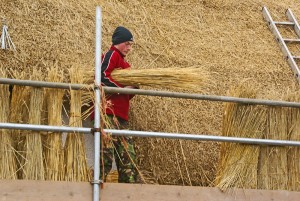Thatch, as the name suggests, is the presence of dead, dry grass on your lawn, and although not as substantial as the stuff you find on the roof of a quaint old cottage, is still pretty thick and dense. All in all this is exactly the kind of material you don’t want interwoven with you luscious green lawn, for reasons that shall soon become apparent.
Common understanding tells us the grass grows from the ground up, and for all intents and purposes this is correct, however there’s more to it than this. As grasses establish some shoots also grow sideways, which is great as it keeps the lawn thick and healthy, but when these shoots die they leave behind an ugly legacy, yep you guessed it, thatch. If left to its own devices, layer upon layer of the stuff will grow over time, eventually starving the life out of whatever living grass is left.

Now it should be noted that the severity of thatch build up varies between grass species, the catch being that the better looking (and feeling) types tend to produce more of it. So as an aside, if you have the opportunity to turf or seed from scratch and don’t have the time or patience for regular lawn care, stick to a species such as Rye which is hard wearing and decomposes slowly, thus producing less thatch. If you do choose to take the more labour intensive option, you’ll reap the benefits of a better looking lawn, but you’ll need to pay special attention to maintaining it, including the need to scarify regularly.
Despite the obvious negative effects that thatch can have on you lawn it can also be beneficial, just the right amount (no more than 10mm) can protect the fledgling grass stems underneath whilst not preventing water from getting to them. Too much more than this and the thatch ends up soaking up the water before it reaches the grass roots, and in time the soil gets starved of all water and nutrition so the grass may start seeding into the thatch instead. If this happens it’s pretty much game over for that patch of grass in it’s current state, and you’ll need to remove the thatch/grass layer, and re-apply turf and/or grass seed as well as water and nutrition to ensure the soil becomes a fertile place once more. Getting this delicate balancing act of the right amount of thatch can be tricky, so if you do opt for a more ‘thatchy’ species on your lawn, you’ll need to be prepared to keep a very close eye on it!


